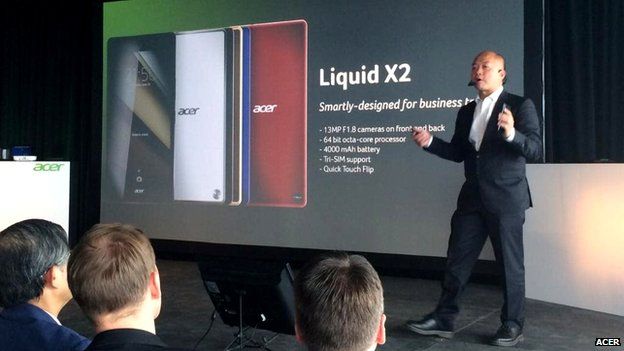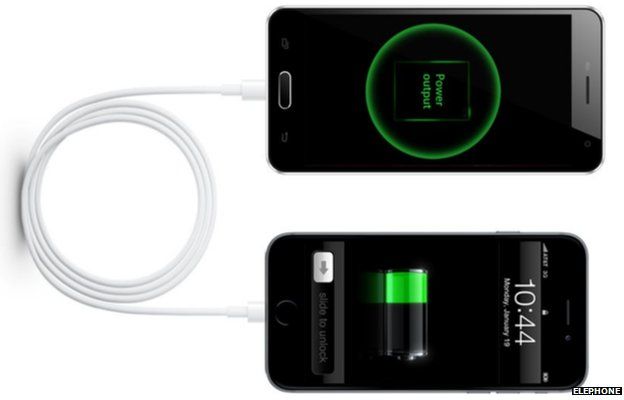Lenovo and Acer smartphones pack huge batteries
Lenovo and Acer have both unveiled smartphones with much larger than normal batteries.A total of three devices from the two companies contain cells with 4,000 milliamp-hour (mAh) capacities.
That is more than a third higher than the components used in Samsung and Apple's latest flagship phones.
Customer surveys have repeatedly highlighted a desire for improved battery life at the top of shopper's most wished for smartphone features.
But until now, batteries of this size have been more commonly found in tablets rather than 5.5in (14cm)-screened phones.

"People are constantly engaged with their screens and the screen uses the most power," explained Ben Wood from the tech consultancy CCS Insight.
"And the biggest challenge right now is that people are also consuming more video content, thanks to the spread of 4G networks, meaning phone battery life is really getting hammered.
"With the bigger brands people are willing to accept some trade-offs for the phones to appear as slim and slick as possible.
"But everyone else is looking for a way of trying to differentiate their devices. And Lenovo and Acer, in particular, have an eye on the business market where employers want their workers to be available for as many hours as possible."
China-based Lenovo says its new K80 offers up to 33 hours of talk-time and its A5000 up to 35 hours. Both figures are based on the use of a 2G network, which is less energy-intensive than a 3G or 4G connection.
Taiwan's Acer has yet to provide a comparable figure for its Liquid X2, which is also unusual for supporting up to three Sim cards at once.
The firms are not the first to use bigger lithium-ion batteries to make their phones stand out.
Last year Motorola developed the Moto Maxx, ahead of its takeover by Lenovo. The handset features a 3,900 mAh battery, which the company said should allow it to survive two days between charges.
And earlier this month Huawei announced the P8 Max with a 4,360mAh battery - although the size of the device's 6.8in (17.3cm) display means that many people would consider it more a call-enabled tablet than a phone.
Some lesser-known handset-makers have opted to fit even bigger, bulkier parts.
Philips's Android-powered Xenium W6610, released last year, has a 5,300mAh cell, allowing it to endure up to three days of heavy use.

And the recently-released Elephone P5000 currently claims the lead with a 5350mAh battery, which the Chinese company says is large enough to let it stretch to four days of "continuous use".
LEADING HANDSETS COMPARED
| Model | Battery capacity |
|---|---|
| Samsung Galaxy S6 Edge | 2,600mAh |
| Samsung Galaxy Note 4 | 3,220mAh |
| Apple iPhone 6 | 1,810mAh |
| Apple iPhone 6 Plus | 2,915mAh |
| LG G3 | 3,000mAh |
| HTC One M9 | 2,840mAh |
| Microsoft Lumia 930 | 2,420mAh |
| Xiaomi Mi Note Pro | 3,000mAh |
| Huawei P8 | 2,680mAh |
| Google Nexus 6 | 3,220mAh |
| Sony Z5 | 2,930mAh |
At a time when it has become the norm for manufacturers to build smartphones with non-removable batteries, it might be expected that those with bigger capacities would enjoy stronger sales.
But one analyst said that despite what shoppers tell surveys, when it comes to buying a personal handset they tend to prioritise other issues such as photo quality, brand or cost.
"If a handset fails to last a minimum of a day then it won't sell, but once you get past that it doesn't really drive demand," said Tim Coulling from the market research firm Canalys.
"Most people have at least one opportunity to charge their phone within that time period and there is also a market in battery packs for power-users.
"The other thing is that the more battery life you have the more you end up using your phone anyway. It's like a pay cheque - no matter how much money you have you always spend it."
Source: BBC News

